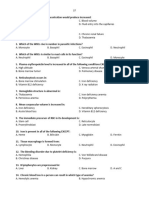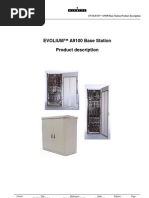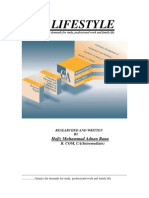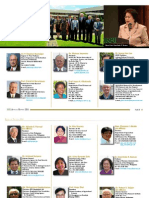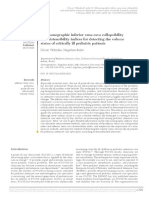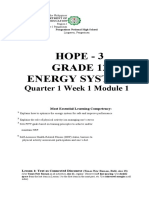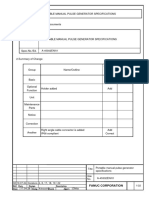QSP 14 Fmea Procedure - 01
QSP 14 Fmea Procedure - 01
Uploaded by
kmvimal36Copyright:
Available Formats
QSP 14 Fmea Procedure - 01
QSP 14 Fmea Procedure - 01
Uploaded by
kmvimal36Original Title
Copyright
Available Formats
Share this document
Did you find this document useful?
Is this content inappropriate?
Copyright:
Available Formats
QSP 14 Fmea Procedure - 01
QSP 14 Fmea Procedure - 01
Uploaded by
kmvimal36Copyright:
Available Formats
SPI/ QSP/14/FMEA
QUALITY SYSTEM PROCEDURE Issue: C
Rev. No: 01
Date: 20.01.2020
FAILURE MODE EFFECTIVE ANALYSIS
Page 1 of 7
1.0 Purpose
This procedure provides a systematic analysis of potential failure modes aimed at preventing
failures. It is intended to be a preventive action process carried out before implementing new or
changes in products or processes. An effective FMEA identifies corrective actions required to
prevent failures from reaching the customer; and to assure the highest possible yield, quality,
and reliability
2.0 Application
This procedure applies to FMEAs are conducted in the product design or process development
stages, although conducting it on existing products and processes may also yield benefits
3.0 Responsibility
Roles, Responsibility and Authority for various activities of ‘Failure Mode Effective analysis
Director, Quality Head and New Product Development Team.
4.0 Terms and definitions
FMEA – Failure Mode Effective analysis
RPN –Risk Priority Number
FM- Failure Modes
5.0 Procedure:
Failure Modes and Effects Analysis (FMEA) is a systematic, proactive method for evaluating
a process to identify where and how it might fail and to assess the relative impact of
different failures, in order to identify the parts of the process that are most in need of
change. FMEA includes review of the following steps:
1. Review the process
2. Review the process every customer complaint with in 30 days
2. Brainstorm potential failure modes
3. List potential effects of each failure mode
4. Assign a severity rating for each effect
5. Assign an occurrence rating for each FM
6. Assign detection rating for each FM and/or effects
7. Calculate the risk priority # (RPN) for each effect
8. Prioritize the FMs for action
9. Take action to eliminate or reduce the high-risk FMs
10. Calculate the Resulting RPN as the FMs are reduced or eliminated
SRI PANDIYAN INDUSTRIES
SPI/ QSP/14/FMEA
QUALITY SYSTEM PROCEDURE Issue: C
Rev. No: 01
Date: 20.01.2020
FAILURE MODE EFFECTIVE ANALYSIS
Page 2 of 7
1.0 Select a process to evaluate with FMEA
Evaluation using FMEA works best on processes of doing an FMEA on a large and complex process, such as
Automotive Product, try doing an FMEA on sub processes or variants. Conducting an FMEA of the entire
IATF 16949:2016 management process would be a task. Instead, consider individual FMEA analyses of the
Process
2.0 Recruit a multidisciplinary team
Be sure to include everyone who is involved at any point in the process. Some people may not need to be
part of the team throughout the entire analysis, but they should certainly be included in discussions of
those steps in the process in which they are involved. For example, a New product development team and
quality executive in the line of production quality delivery for all the products
3.0 Have the team meet together to list all of the steps in the process
Number every step of the process, and be as specific as possible. It may take several meetings for
the team to complete this part of the FMEA, depending on the number of steps and the complexity of
the process. Flowcharting can be a helpful tool for outlining the steps. When you are finished, be
sure to obtain consensus from the group. The team should agree that the steps enumerated in the
FMEA accurately describe the process.
4.0 Have the team list failure modes and causes
For each step in the process, list all possible “failure modes”—that is, anything that could go wrong,
including minor and rare problems. Then, for each failure mode listed, identify all possible causes
5.0 For each failure mode, have the team assign a numeric value (known as the Risk
Priority Number, or RPN) for likelihood of occurrence, likelihood of detection, and severity
Assigning RPNs helps the team prioritize areas to focus on and can also help in assessing
opportunities for improvement. For every failure mode identified, the team should answer the
following questions and assign the appropriate score (the team should do this as a group and have
consensus on all values assigned):
The Risk Priority Number (RPN) methodology is a technique for analyzing the risk associated with
potential problems identified during a Failure Mode and Effects Analysis (FMEA). This article presents
a brief overview of the basic RPN method and then examines some additional and alternative ways to
use RPN ratings to evaluate the risk associated with a product or process design and to prioritize
problems for corrective action. Note that this article discusses RPNs calculated at the level of the
potential causes of failure (Severity x Occurrence x Detection). However, there is a great deal of
variation among FMEA practitioners as to the specific analysis procedure and some analyses may
include alternative calculation methods.
SRI PANDIYAN INDUSTRIES
SPI/ QSP/14/FMEA
QUALITY SYSTEM PROCEDURE Issue: C
Rev. No: 01
Date: 20.01.2020
FAILURE MODE EFFECTIVE ANALYSIS
Page 3 of 7
5.1 Overview of Risk Priority Numbers An FMEA can be performed to identify the potential failure
modes for a product or process. The RPN method then requires the analysis team to use past experience
and engineering judgment to rate each potential problem according to three rating scales:
Severity, which rates the severity of the potential effect of the failure.
Occurrence, which rates the likelihood that the failure will occur.
Detection, which rates the likelihood that the problem will be detected before it reaches the
end-user/customer.
Rating scales usually range from 1 to 10, with the higher number representing the higher seriousness or
risk. For example, on a ten point Occurrence scale, 10 indicates that the failure is very likely to occur and is
worse than 1, which indicates that the failure is very unlikely to occur. The specific rating descriptions and
criteria are defined by the organization or the analysis team to fit the products or processes that are being
analyzed. As an example
Rating Description Criteria
1 No No effect
2 Very slight Customer not annoyed very slight effect on
product or system performance
3 Slight Customer slightly annoyed. Slight effect on product or system
performance
4 Minor Customer experiences minor nuisance. Minor effect on
product or system performance
5 Moderate Customer experiences some dissatisfaction. Moderate effect
on product or system performance
6 Significant Customer experiences discomfort. Product performance
degraded, but operable and safe. Partial failure, but
operable
7 Major Customer dissatisfied. Product performance severely affected
but function able and safe. System impaired.
8 Extreme Customer very dissatisfied. Product inoperable but safe.
System inoperable
9 Serious Potential hazardous effect. Able to stop product without
mishap time dependent failure. Compliance with
government regulation is in jeopardy
10 Hazardous Hazardous effect. Safety related sudden failure. Non-
SRI PANDIYAN INDUSTRIES
SPI/ QSP/14/FMEA
QUALITY SYSTEM PROCEDURE Issue: C
Rev. No: 01
Date: 20.01.2020
FAILURE MODE EFFECTIVE ANALYSIS
Page 4 of 7
compliance with government regulation
Qualitative scale for the severity index (S)
Rating Description Criteria
1 Almost never Failure unlikely. History shows no failure
2 Remote Rare number of failures likely
3 Very slight Very few failures likely.
4 Slight Few failures likely
5 Low Occasional number of failures likely
6 Medium Medium number of failures likely.
7 Moderately high Moderately high number of failures likely.
8 High High number of failures likely
9 Very high Very high number of failures likely
10 Almost certain Failure almost certain. History of failures e x i s t s
from previous or similar designs.
Qualitative scale for the occurrence index (O)
Rating Description Criteria
1 Almost certain Proven detection methods available in concept stage
2 Very high Proven computer analysis available in early design
stage
3 High Simulation and/ or modeling in early stage.
4 Moderately high Tests on early prototype system elements.
5 Medium Tests on preproduction system components.
6 Low Tests on similar system components.
7 Slight Tests on product with prototypes with system
components installed.
8 Very slight Proving durability tests on products with system
components installed
9 Remote Only unproven or unreliable technique(s) available.
10 Almost impossible No known techniques available
. Qualitative scale for the detection index (D)
SRI PANDIYAN INDUSTRIES
SPI/ QSP/14/FMEA
QUALITY SYSTEM PROCEDURE Issue: C
Rev. No: 01
Date: 20.01.2020
FAILURE MODE EFFECTIVE ANALYSIS
Page 5 of 7
After the ratings have been assigned, the RPN for each issue is calculated by multiplying Severity x
Occurrence x Detection.
The RPN value for each potential problem can then be used to compare the issues identified within the
analysis. Typically, if the RPN falls within a pre-determined range, corrective action may be
recommended or required to reduce the risk (i.e., to reduce the likelihood of occurrence, increase the
likelihood of prior detection or, if possible, reduce the severity of the failure effect). When using this
risk assessment technique, it is important to remember that RPN ratings are relative to a particular
analysis (performed with a common set of rating scales and an analysis team that strives to make
consistent rating assignments for all issues identified within the analysis). Therefore, an RPN in one
analysis is comparable to other RPNs in the same analysis but it may not be comparable to RPNs in
another analysis.
The rest of this article discusses related techniques that can be used in addition to or instead of the
basic RPN method described here.
6.0 Revised RPNs and Percent Reduction in RPN
In some cases, it may be appropriate to revise the initial risk assessment based on the assumption (or
the fact) that the recommended actions have been completed. This provides an indication of the
effectiveness of corrective actions and can also be used to evaluate the value to the organization of
performing the FMEA. To calculate revised RPNs, the analysis team assigns a second set of Severity,
Occurrence and Detection ratings for each issue (using the same rating scales) and multiplies the revised
ratings to calculate the revised RPNs. If both initial and revised RPNs have been assigned, the percent
reduction in RPN can also be calculated as follows:
For example, if the initial ratings for a potential problem are S = 7, O = 8 and D = 5 and the revised
ratings are S = 7, O = 6 and D = 4, then the percent reduction in RPN from initial to revised is (280-
168)/280, or 40%. This indicates that the organization was able to reduce the risk associated with the
issue by 40% through the performance of the FMEA and the implementation of corrective actions.
SRI PANDIYAN INDUSTRIES
SPI/ QSP/14/FMEA
QUALITY SYSTEM PROCEDURE Issue: C
Rev. No: 01
Date: 20.01.2020
FAILURE MODE EFFECTIVE ANALYSIS
Page 6 of 7
7.0 Conclusion
As this article demonstrates, the Risk Priority Number (RPN) methodology can be used to assess the risk
associated with potential problems in a product or process design and to prioritize issues for corrective
action. A particular analysis team may choose to supplement or replace the basic RPN methodology with
other related techniques, such as revised RPNs, the Occurrence/Severity matrix, ranking lists, risk
ranking tables and/or higher level RPNs. All of these techniques rely heavily on engineering judgment
and must be customized to fit the product or process that is being analyzed and the particular
needs/priorities of the organization.
Changes
Required changes of this Procedure have to be directed in writing to the team leader of this
Procedure. Such change requests will be discussed within the team and in case of improvement
implemented into the Procedure. The changes have to be described in the revision sheet.
Responsible for documentation and change of the Procedure on the sheet “Revision” is the team
leader.
8.0 Distribution
After release by the QMS Co-Ordinator this Quality System Procedure will be released with
controlled copy to related department as per the distribution list of documents by QMS Co-
Ordinator.
SRI PANDIYAN INDUSTRIES
SPI/ QSP/14/FMEA
QUALITY SYSTEM PROCEDURE Issue: C
Rev. No: 01
Date: 20.01.2020
FAILURE MODE EFFECTIVE ANALYSIS
Page 7 of 7
9.0 Revisions
Sl:
Revision Date Description of change
No
1 C/00 01.01.2019 New release for IATF16949:2016 Standard
2 C/01 20.01.2020 Every customer complaint review FMEA with 30 days
Revisions authorized by:
Prepared: 20.01.2020 K.M.VIMAL KUMAR
_____________________________ _______________________________________________________________________________________________________________
Date QMS Coordinator
Approved: 20.01.2020 P.GANESH KANDHASAMY
___________________________ _______________________________________________________________________________________________________________
Date MANAGING DIRECTOR
SRI PANDIYAN INDUSTRIES
You might also like
- First Year Complete Physiology MCQ Bank by Team DR Of2027-28100% (4)First Year Complete Physiology MCQ Bank by Team DR Of2027-28284 pages
- Midterm Exam in Hairdressing NC II-Grade 12 (1st Sem)0% (1)Midterm Exam in Hairdressing NC II-Grade 12 (1st Sem)2 pages
- Failure Modes and Effect Analysis of Electro-Pneumatics SystemNo ratings yetFailure Modes and Effect Analysis of Electro-Pneumatics System9 pages
- Problem Solving and Analysis Tools Failure Modes and Effects Analysis - FmeaNo ratings yetProblem Solving and Analysis Tools Failure Modes and Effects Analysis - Fmea7 pages
- FMEA and You: by Robert A. Dovich, ASQ, Fellow, CQE, CRE, Quality Manager, Field Fastener Supply CompanyNo ratings yetFMEA and You: by Robert A. Dovich, ASQ, Fellow, CQE, CRE, Quality Manager, Field Fastener Supply Company2 pages
- Failure Mode and Effects Analysis - GoSkills Course SyllabusNo ratings yetFailure Mode and Effects Analysis - GoSkills Course Syllabus3 pages
- Risk Analysis Method: FMEA/FMECA in The OrganizationsNo ratings yetRisk Analysis Method: FMEA/FMECA in The Organizations9 pages
- Designing and Maintaining A Robust Equipment Cleaning Program For BiologicsNo ratings yetDesigning and Maintaining A Robust Equipment Cleaning Program For Biologics55 pages
- Quality Manual: Subject: Procedure For PFMEA71% (7)Quality Manual: Subject: Procedure For PFMEA3 pages
- Failure Modes & Effects Analysis: Project Activities in Which The FMEA Is UsefulNo ratings yetFailure Modes & Effects Analysis: Project Activities in Which The FMEA Is Useful10 pages
- Failure Mode and Effects Analysis of Hotwell System Motor Operated Butterfly ValveNo ratings yetFailure Mode and Effects Analysis of Hotwell System Motor Operated Butterfly Valve19 pages
- Failure Mode: Professor: IE Johnnathan Fernando Gutiérrez CruzNo ratings yetFailure Mode: Professor: IE Johnnathan Fernando Gutiérrez Cruz39 pages
- Failure Mode and Effects Analysis (Design) : Importance in NPD ProcessNo ratings yetFailure Mode and Effects Analysis (Design) : Importance in NPD Process12 pages
- Analyze Opportunity Part 1: Failure Modes Effect Analysis (FMEA)No ratings yetAnalyze Opportunity Part 1: Failure Modes Effect Analysis (FMEA)36 pages
- FMEA: Failure Modes and Effects AnalysisNo ratings yetFMEA: Failure Modes and Effects Analysis24 pages
- Corrective Action and Preventive Action (CAPA) in Pharmaceutical IndustryFrom EverandCorrective Action and Preventive Action (CAPA) in Pharmaceutical IndustryNo ratings yet
- From Test Tubes to Tonnes: Commercial Drug Process Development for Life Scientists: Life After Life Science, #4From EverandFrom Test Tubes to Tonnes: Commercial Drug Process Development for Life Scientists: Life After Life Science, #4No ratings yet
- Practical Guide to FMEA : A Proactive Approach to Failure AnalysisFrom EverandPractical Guide to FMEA : A Proactive Approach to Failure Analysis5/5 (1)
- ISTQB Certified Tester Advanced Level Test Manager (CTAL-TM): Practice Questions Syllabus 2012From EverandISTQB Certified Tester Advanced Level Test Manager (CTAL-TM): Practice Questions Syllabus 2012No ratings yet
- Troubleshooting Rotating Machinery: Including Centrifugal Pumps and Compressors, Reciprocating Pumps and Compressors, Fans, Steam Turbines, Electric Motors, and MoreFrom EverandTroubleshooting Rotating Machinery: Including Centrifugal Pumps and Compressors, Reciprocating Pumps and Compressors, Fans, Steam Turbines, Electric Motors, and More5/5 (1)
- Guidelines for Asset Integrity ManagementFrom EverandGuidelines for Asset Integrity Management5/5 (1)
- Puppy Reservation Form and Guarantee Dec 2013No ratings yetPuppy Reservation Form and Guarantee Dec 20131 page
- EVOLIUM A9100 Base Station Product Description100% (1)EVOLIUM A9100 Base Station Product Description77 pages
- Oferta Completa Alfabetica 2022 17.11.2022No ratings yetOferta Completa Alfabetica 2022 17.11.202243 pages
- Inert Gas: Sugar Grape Must Alcohol Carbonic Maceration Beaujolais Storage Nitrogen ArgonNo ratings yetInert Gas: Sugar Grape Must Alcohol Carbonic Maceration Beaujolais Storage Nitrogen Argon1 page
- API 614-Chapter 4 DATA SHEET Dry Gas Seal Module Si Units: System Responsibility: (2.1.2)No ratings yetAPI 614-Chapter 4 DATA SHEET Dry Gas Seal Module Si Units: System Responsibility: (2.1.2)10 pages
- Electrical Wiring Interconnection SystemNo ratings yetElectrical Wiring Interconnection System39 pages
- Sort - SEIRI: Checklist Item Criteria Exist? Rating CommentsNo ratings yetSort - SEIRI: Checklist Item Criteria Exist? Rating Comments2 pages
- Complete Download Bully Me: Class of 2020 1st Edition Various Authors PDF All Chapters100% (4)Complete Download Bully Me: Class of 2020 1st Edition Various Authors PDF All Chapters55 pages
- Ultrasonographic Inferior Vena Cava Collapsibility and Distensibility Indices For Detecting The Volume Status of Critically Ill Pediatric PatientsNo ratings yetUltrasonographic Inferior Vena Cava Collapsibility and Distensibility Indices For Detecting The Volume Status of Critically Ill Pediatric Patients5 pages
- Hope - 3 Grade 12 Energy System: Quarter 1 Week 1 Module 1No ratings yetHope - 3 Grade 12 Energy System: Quarter 1 Week 1 Module 15 pages
- Cost Accumulationjournal Entries, Cost of Goods Manufactured With SolutionsNo ratings yetCost Accumulationjournal Entries, Cost of Goods Manufactured With Solutions4 pages
- TMN19 - 161E Portable Manual Pulse GeneratorNo ratings yetTMN19 - 161E Portable Manual Pulse Generator22 pages
- OUI ROI FINAL 20210219 Redacted - RedactedNo ratings yetOUI ROI FINAL 20210219 Redacted - Redacted47 pages
- Silat Suffian Bella Diri: Seminar Registration Form 2017 Two Days of Silat Suffian Bela Diri With Guru Maul MornieNo ratings yetSilat Suffian Bella Diri: Seminar Registration Form 2017 Two Days of Silat Suffian Bela Diri With Guru Maul Mornie1 page
- First Year Complete Physiology MCQ Bank by Team DR Of2027-28First Year Complete Physiology MCQ Bank by Team DR Of2027-28
- ISTQB Certified Tester Foundation Level Practice Exam QuestionsFrom EverandISTQB Certified Tester Foundation Level Practice Exam Questions
- Midterm Exam in Hairdressing NC II-Grade 12 (1st Sem)Midterm Exam in Hairdressing NC II-Grade 12 (1st Sem)
- Failure Modes and Effect Analysis of Electro-Pneumatics SystemFailure Modes and Effect Analysis of Electro-Pneumatics System
- Problem Solving and Analysis Tools Failure Modes and Effects Analysis - FmeaProblem Solving and Analysis Tools Failure Modes and Effects Analysis - Fmea
- FMEA and You: by Robert A. Dovich, ASQ, Fellow, CQE, CRE, Quality Manager, Field Fastener Supply CompanyFMEA and You: by Robert A. Dovich, ASQ, Fellow, CQE, CRE, Quality Manager, Field Fastener Supply Company
- Failure Mode and Effects Analysis - GoSkills Course SyllabusFailure Mode and Effects Analysis - GoSkills Course Syllabus
- Risk Analysis Method: FMEA/FMECA in The OrganizationsRisk Analysis Method: FMEA/FMECA in The Organizations
- Designing and Maintaining A Robust Equipment Cleaning Program For BiologicsDesigning and Maintaining A Robust Equipment Cleaning Program For Biologics
- Failure Modes & Effects Analysis: Project Activities in Which The FMEA Is UsefulFailure Modes & Effects Analysis: Project Activities in Which The FMEA Is Useful
- Failure Mode and Effects Analysis of Hotwell System Motor Operated Butterfly ValveFailure Mode and Effects Analysis of Hotwell System Motor Operated Butterfly Valve
- Failure Mode: Professor: IE Johnnathan Fernando Gutiérrez CruzFailure Mode: Professor: IE Johnnathan Fernando Gutiérrez Cruz
- Failure Mode and Effects Analysis (Design) : Importance in NPD ProcessFailure Mode and Effects Analysis (Design) : Importance in NPD Process
- Analyze Opportunity Part 1: Failure Modes Effect Analysis (FMEA)Analyze Opportunity Part 1: Failure Modes Effect Analysis (FMEA)
- Corrective Action and Preventive Action (CAPA) in Pharmaceutical IndustryFrom EverandCorrective Action and Preventive Action (CAPA) in Pharmaceutical Industry
- From Test Tubes to Tonnes: Commercial Drug Process Development for Life Scientists: Life After Life Science, #4From EverandFrom Test Tubes to Tonnes: Commercial Drug Process Development for Life Scientists: Life After Life Science, #4
- Practical Guide to FMEA : A Proactive Approach to Failure AnalysisFrom EverandPractical Guide to FMEA : A Proactive Approach to Failure Analysis
- ISTQB Certified Tester Advanced Level Test Manager (CTAL-TM): Practice Questions Syllabus 2012From EverandISTQB Certified Tester Advanced Level Test Manager (CTAL-TM): Practice Questions Syllabus 2012
- Troubleshooting Rotating Machinery: Including Centrifugal Pumps and Compressors, Reciprocating Pumps and Compressors, Fans, Steam Turbines, Electric Motors, and MoreFrom EverandTroubleshooting Rotating Machinery: Including Centrifugal Pumps and Compressors, Reciprocating Pumps and Compressors, Fans, Steam Turbines, Electric Motors, and More
- Inert Gas: Sugar Grape Must Alcohol Carbonic Maceration Beaujolais Storage Nitrogen ArgonInert Gas: Sugar Grape Must Alcohol Carbonic Maceration Beaujolais Storage Nitrogen Argon
- API 614-Chapter 4 DATA SHEET Dry Gas Seal Module Si Units: System Responsibility: (2.1.2)API 614-Chapter 4 DATA SHEET Dry Gas Seal Module Si Units: System Responsibility: (2.1.2)
- Sort - SEIRI: Checklist Item Criteria Exist? Rating CommentsSort - SEIRI: Checklist Item Criteria Exist? Rating Comments
- Complete Download Bully Me: Class of 2020 1st Edition Various Authors PDF All ChaptersComplete Download Bully Me: Class of 2020 1st Edition Various Authors PDF All Chapters
- Ultrasonographic Inferior Vena Cava Collapsibility and Distensibility Indices For Detecting The Volume Status of Critically Ill Pediatric PatientsUltrasonographic Inferior Vena Cava Collapsibility and Distensibility Indices For Detecting The Volume Status of Critically Ill Pediatric Patients
- Hope - 3 Grade 12 Energy System: Quarter 1 Week 1 Module 1Hope - 3 Grade 12 Energy System: Quarter 1 Week 1 Module 1
- Cost Accumulationjournal Entries, Cost of Goods Manufactured With SolutionsCost Accumulationjournal Entries, Cost of Goods Manufactured With Solutions
- Silat Suffian Bella Diri: Seminar Registration Form 2017 Two Days of Silat Suffian Bela Diri With Guru Maul MornieSilat Suffian Bella Diri: Seminar Registration Form 2017 Two Days of Silat Suffian Bela Diri With Guru Maul Mornie


